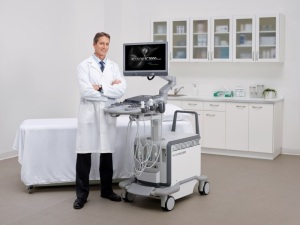by
Thomas Dworetzky, Contributing Reporter | September 06, 2017
New features in release 5.0 of the ACUSON SC2000 designed to improve navigation and guidance during structural heart disease interventions have been given clearance by the FDA.
Called TrueFusion, the new cardiovascular application integrates ultrasound and angiography images.
“With the availability of the TrueFusion cardiovascular application, Siemens Healthineers provides our customers with an invaluable tool to aid in the diagnosis, treatment, and follow-up of patients with structural heart disease,” David Pacitti, president and head of Siemens Healthineers North America, said in a statement.
The new application works for interventional cardiology procedures as well as diagnosis and follow-up of patients with structural heart disease.
This approach of “fusing” images for structural heart procedures is a fast-moving area of technology development that brings together not just different modes of imaging, but also multidisciplinary clinical teams.
In order to carry out both the diagnosis and interventions, these teams need the ability to see “detailed, real-time imaging information – specifically, real-time soft tissue and blood flow information from echocardiography, as well as 2-D imaging information from fluoroscopy,” according to the company.
To help meet these demands, TrueFusion communicates anatomical and functional markers and valve models from the ACUSON SC2000’s True Volume transesophageal echocardiography (TEE) transducer to an Artis with PURE angiography system.
It overlays ultrasound data via live fluoroscope imaging, as well.
“By directly and seamlessly integrating co-registration of Artis fluoro and ACUSON SC2000 echo into the workflow via machine learning-based probe detection and automated registration updates, TrueFusion enables clinical teams to identify soft tissue-based structures that are provided directly from the integrated ultrasound system,” according to Siemens.
This lets both echocardiographers and interventionists communicate more easily, in order to find “more intuitive anatomical orientation” while performing tasks — as well as working more quickly.
This potentially reduces the use of contrast during challenging procedures, and lowers the amount of time patients and practitioners are exposed to X-rays.
The FDA approved the Prime edition of the ACUSON SC2000 ultrasound system in late 2014. At that time it was Siemens' first system with true volume 3-D transesophageal echo (TEE) with 90 degree by 90 degree acquisition and full-volume color Doppler.
"When interventionalists or surgeons are trying to image the heart, they can capture all of the anatomy of the heart with that 90 by 90 field of view," Saurabh Datta, product manager for ACUSON SC2000 Prime at Siemens,
told HCB News at the time.
The global structural heart imaging market
is expected to hit $25.3 billion by 2025, according to an August Grand View Research report.
The echocardiogram segment of the market in 2016 was “dominant,” and the market researchers advised that it should take about 50 percent of the 2025 market. MR imaging should have the fastest growth rate as its technology advances, and also because it doesn't use ionizing radiation like CT, which makes it more suitable for pregnant women and others for whom that is a concern.
